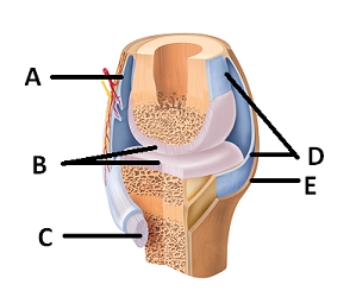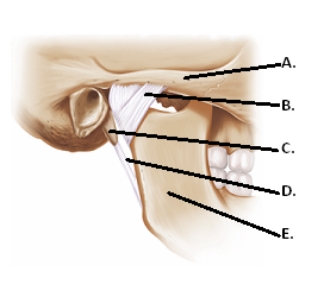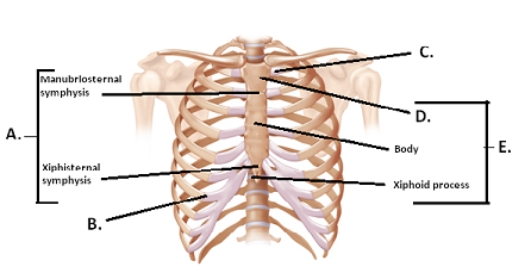A) bones that are united at the joint.
B) structure of the joint.
C) size of the joint.
D) shape of the joint.
E) type of fluid in the joint.
G) D) and E)
Correct Answer

verified
Correct Answer
verified
Multiple Choice
Osteoarthritis is
A) a bacterial infection transmitted by ticks.
B) an inflammation of any joint.
C) a metabolic disorder caused by increased uric acid in blood.
D) a condition that may involve an autoimmune disease.
E) the most common type of arthritis.
G) A) and B)
Correct Answer

verified
Correct Answer
verified
Multiple Choice
Mary Lu is experiencing pain from her sacroiliac joint.In what region of her body is she most likely feeling pain?
A) posterior pelvic region
B) anterior pelvic region
C) cervical region
D) lumbar region
E) thoracic region
G) A) and C)
Correct Answer

verified
Correct Answer
verified
Multiple Choice
The subscapular and subacromial bursa are associated with the _________ joint.
A) elbow
B) knee
C) shoulder
D) hip
E) wrist
G) A) and E)
Correct Answer

verified
Correct Answer
verified
Multiple Choice
An example of a saddle joint is the
A) shoulder joint.
B) elbow joint.
C) atlanto-occipital joint.
D) carpometacarpal joint.
E) atlantoaxial joint.
G) A) and E)
Correct Answer

verified
Correct Answer
verified
Multiple Choice
Jasmine trips and tries to break her fall by putting her hand to the ground.The doctor informs her she has injured the ____ joints in her wrist.
A) costocarpal joints.
B) intermetacarpal joints.
C) metacarpalphalangeal joints.
D) intercarpal joints.
E) intracarpal joints.
G) A) and D)
Correct Answer

verified
Correct Answer
verified
Multiple Choice
Turning a structure around its longitudinal axis is called
A) circumduction.
B) rotation.
C) hyperextension.
D) supination.
E) pronation.
G) A) and B)
Correct Answer

verified
Correct Answer
verified
Multiple Choice
The joint between the head of the radius and the proximal end of the ulna is a _____ joint.
A) plane
B) saddle
C) hinge
D) pivot
E) ball and socket
G) B) and C)
Correct Answer

verified
Correct Answer
verified
Multiple Choice
Which of the following is mismatched?
A) shoulder joint - coracohumeral ligament
B) elbow joint - radial collateral ligaments
C) hip joint - cruciate ligaments
D) knee joint - patellar ligaments
E) ankle - calcaneofibular ligament
G) B) and E)
Correct Answer

verified
Correct Answer
verified
Multiple Choice
The thick fibrocartilage disks found in the knee joint are called
A) bursae.
B) ligaments.
C) tendon sheaths.
D) menisci.
E) intraknee disks.
G) A) and C)
Correct Answer

verified
Correct Answer
verified
Multiple Choice
 -What does structure "E" represent on the diagram?
-What does structure "E" represent on the diagram?
A) tendon
B) articular cartilage
C) bursa
D) fibrous capsule
E) synovial membrane
G) C) and E)
Correct Answer

verified
Correct Answer
verified
Multiple Choice
Which of the following is NOT a cartilaginous joint?
A) epiphyseal plates
B) intervertebral disks
C) fontanelles
D) sternocostal joint
E) manubriosternal joint
G) None of the above
Correct Answer

verified
Correct Answer
verified
Multiple Choice
 -The figure illustrates structures in the right temporomandibular joint (lateral view) .What does "B" represent?
-The figure illustrates structures in the right temporomandibular joint (lateral view) .What does "B" represent?
A) lateral ligament
B) mandible
C) zygomatic arch
D) styloid process
E) stylomandibular ligament
G) B) and E)
Correct Answer

verified
Correct Answer
verified
Multiple Choice
 -The figure illustrates the joints and bones of the rib cage.What does "B" represent?
-The figure illustrates the joints and bones of the rib cage.What does "B" represent?
A) costochondral joint
B) sternum
C) manubrium
D) sternal symphyses
E) sternocostal synchrondrosis
G) B) and D)
Correct Answer

verified
Correct Answer
verified
Multiple Choice
A joint that has no joint cavity and exhibits little or no movement would be classified as a
A) fibrous joint.
B) synovial joint.
C) complex joint.
D) cartilaginous joint.
E) partial joint.
G) D) and E)
Correct Answer

verified
Correct Answer
verified
Multiple Choice
If you stepped in a hole in the yard and sprained your ankle,you have
A) fractured the fibula.
B) fractured the tibia.
C) torn a ligament of the ankle.
D) torn cartilage on the talus bone.
E) fractured the calcaneous.
G) B) and C)
Correct Answer

verified
Correct Answer
verified
Multiple Choice
The function of a bursa is to
A) provide support for a weak joint.
B) provide a fluid-filled cushion that reduces friction.
C) increase the articulating surface at a joint.
D) bind ligaments to bones.
E) produce fluid.
G) C) and D)
Correct Answer

verified
Correct Answer
verified
Multiple Choice
Which of the following pairs of terms are opposites?
A) plantar flexion - dorsiflexion
B) abduction - extension
C) inversion - retraction
D) pronation - rotation
E) elevation - protraction
G) A) and C)
Correct Answer

verified
Correct Answer
verified
Multiple Choice
 -What does structure "C" represent on the diagram?
-What does structure "C" represent on the diagram?
A) tendon
B) articular cartilage
C) bursa
D) fibrous capsule
E) synovial membrane
G) B) and C)
Correct Answer

verified
Correct Answer
verified
Showing 101 - 119 of 119
Related Exams